Outforia Quicktake: Key Takeaways
- The largest great white shark is a matter of debate, with a shark named Deep Blue often being identified as the biggest. Great white sharks often average 15 feet (4.6 meters) or less in length, but some individuals, like Deep Blue, are larger.
- Great white sharks, the largest predatory fish in the world, belong to the family Lamnidae, also referred to as the mackerel shark family. They have a defined color difference separating their white underside from the gray to brownish-gray dorsal surface.
- Their habitat ranges across the globe, though they’re most common in coastal waters and areas where seal and sea lion colonies are found. They’re known to migrate long distances in pelagic waters.
- Deep Blue, first discovered in the late 1990s, is estimated to be about 20 feet (6 meters) long and to weigh around 5,000 pounds (2,268 kg). However, bigger sharks have been recorded, such as the shark caught off the coast of Cuba in the Gulf of Mexico in 1945, grossing 7,100 pounds (3,220 kg) and measuring 21 feet (6.4 m) in length.
- Despite the large size of great white sharks, the whale shark is the largest fish and shark alive today, averaging around 22,000 pounds (9,979 kg) and growing up to 39 feet (12 meters) in length.
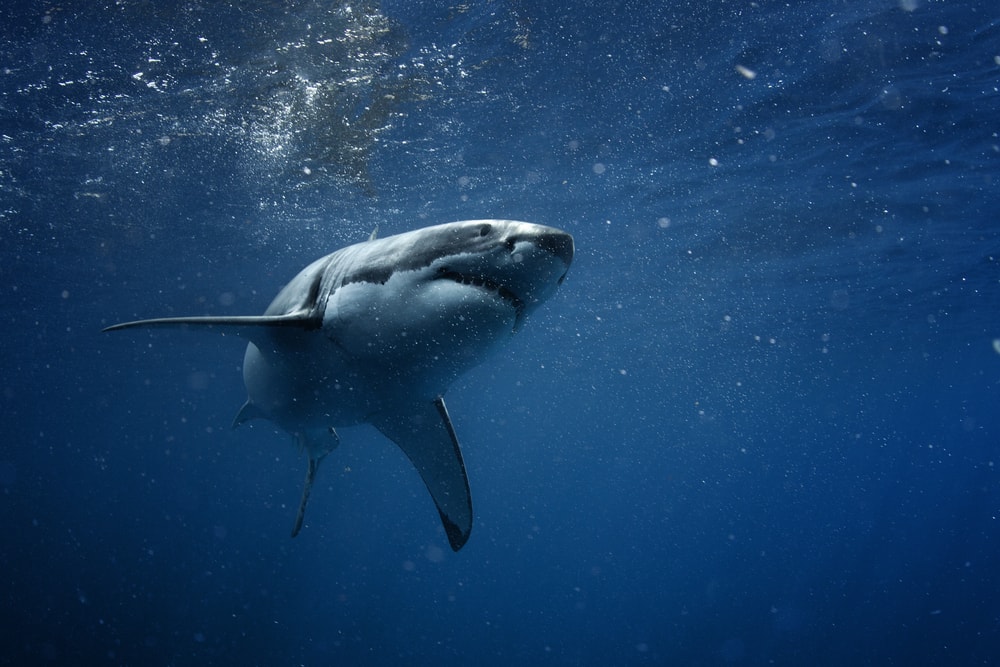
Great white sharks are among the most commonly known and well-studied shark species. Often appearing in films as massive beasts, the great white shark is the largest predatory fish in the world.
Most great white sharks average 15 feet (4.6 meters) or less in length, but some larger individuals have been confirmed.
As of 2023, Deep Blue is generally accepted as the biggest great white shark in the world. However, there is some debate as to whether Deep Blue is truly the largest great white shark ever recorded.
What is a Great White Shark?
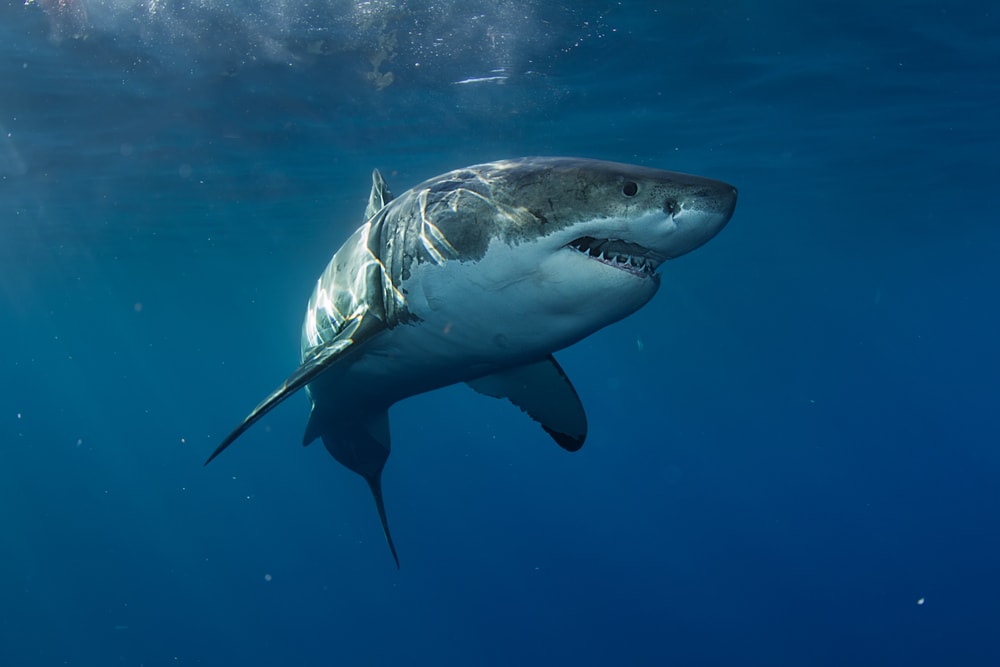
Great white sharks (Carcharodon carcharias), also called white sharks, belong to the family Lamnidae, also referred to as the mackerel shark family.
Other members of this family include other large, predatory fish such as mako, porbeagle, and salmon sharks.
Great white sharks are easy to distinguish from other types of sharks because of their size, color, and shape.
Great whites have a defined color difference separating their white underside from the gray to brownish-gray dorsal surface. They have a torpedo-shaped body and conical snout, like other mackerel shark species.
The great white shark is considered an apex predator and sits at the top of the food chain. Protections are in place for this species due to its role as an apex predator.
Adult great white sharks prefer to eat marine mammals, such as seals, sea lions, and dolphins. They’ve also been observed scavenging dead whales. Many shark species feed at night, but great whites feed during the day.
Habitat and Range

Me – Own work / CC BY-SA 3.0 / Wikimedia Commons
The habitat and range of great white sharks have allowed scientists and researchers to closely study the species.
Although they’re known to migrate long distances in pelagic waters, great whites like to hang around nearshore waters.
Juveniles are most common in coastal waters due to their preferred feeding habits. Adults are more common in the open ocean and areas where seal and sea lion colonies are found.
In the western Atlantic Ocean, their range extends from Newfoundland, Canada, south to the Gulf of Mexico and Caribbean. Some individuals have been spotted as far south as Argentina.
In the eastern Pacific Ocean, great whites occur as far north as Alaska and south to Chile.
They’re also found in the eastern Atlantic, the Pacific, and the Indian Ocean. Although they’ve been sighted in tropical waters, great whites prefer temperate and subtropical waters.
How Big Are Great White Sharks?
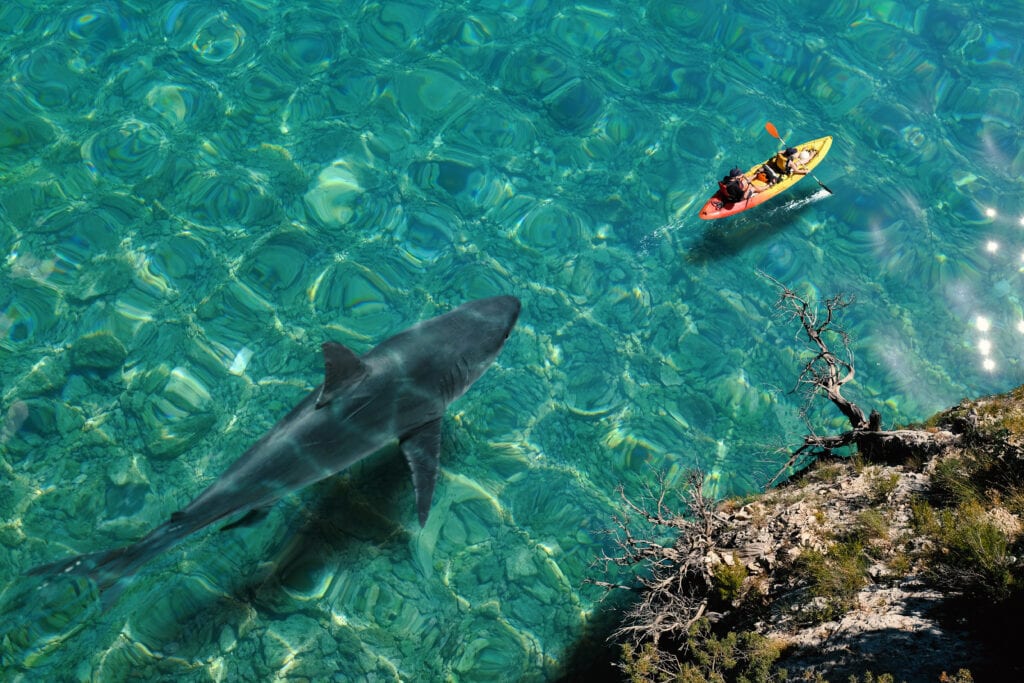
The great white shark is the largest species in the mackerel shark family. It’s also the largest predatory fish. However, great white sharks aren’t the biggest sharks in the world.
Male great white sharks are smaller than females. Males average about 11–13 ft (3.4–4 m) in length, while females average up to 16 ft (4.8 m) in length. Some females have surpassed this size, reaching up to 20 feet (6 meters) in length.
Great white sharks are large-bodied and can weigh up to 4,500 pounds (2,041 kg) or more.
Baby great whites are born after a gestation period of about 12 months. Great white embryos develop inside an egg in the mother’s stomach. Once fully developed, females give birth to live young measuring about 4 ft (1.2 m) in length.
Large female great whites are known to give birth to more pups. Great whites usually have a litter of 2–12 pups.
Biggest Great White Shark Recorded
The biggest great white shark is largely up for debate. A female great white named Deep Blue is generally recognized as the largest great white shark in the world.
Deep Blue was first discovered in the late 1990s. She was spotted again in 2012 during the filming of the Discovery Channel’s Shark Week TV program. Marine biologist Mauricio Hoyos Padilla captured the footage of Deep Blue.
Deep Blue received viral attention in 2014 after she appeared on Season 27, Episode 1 of the Shark Week documentary series entitled “Jaws Strikes Back”.
The team of marine biologists and shark experts traveled to Guadalupe, Mexico, in the Pacific to film great white shark hunting behaviors. The team encountered Deep Blue and captured footage of the massive shark.
Deep Blue hasn’t been scientifically measured or weighed yet, so her size is based on sightings and footage. It’s estimated that Deep Blue is about 20 feet (6 meters) long and weighs around 5,000 pounds (2,268 kg).
Sightings of Deep Blue are very rare. A viral video of freediver Ocean Ramsey took over the internet in 2019 when Ramsey claimed to be swimming next to the famous Deep Blue off the coast of Oahu, Hawai’i. However, some questioned whether the shark was truly Deep Blue.
There are claims that the large great white was actually another female named Haole Girl who may have been pregnant or just finished a large meal.
Largest Great White Shark Sightings
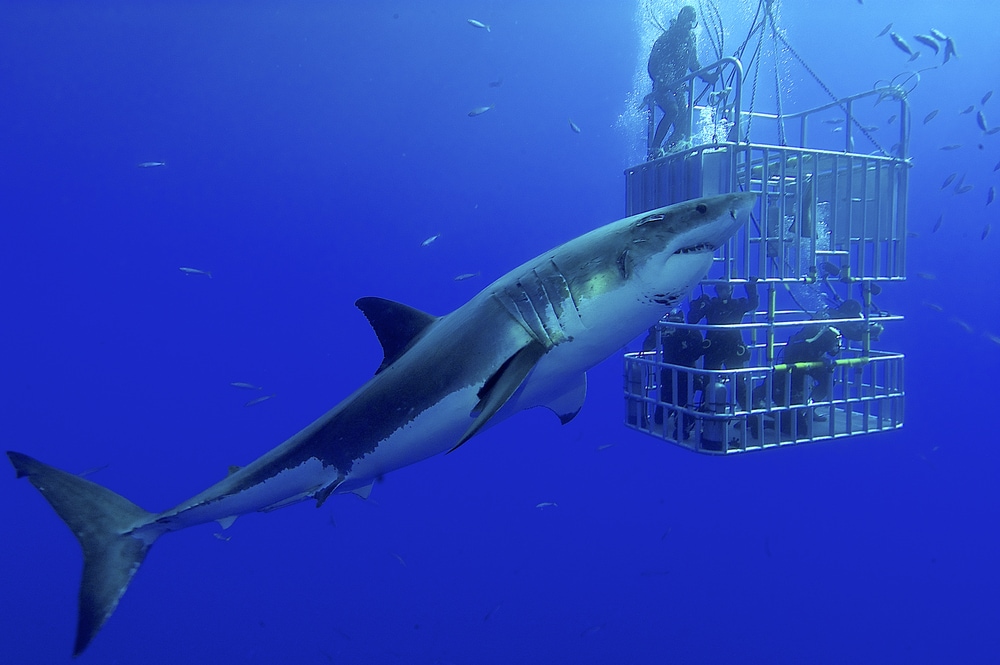
Although Deep Blue has been labeled as the largest great white shark in the world, there are records of other larger great whites.
President and executive director of the Marine Conservation Science Institute, Michael Domeier, spoke out about the attention Deep Blue was getting.
In an Instagram post, Domeier claimed that Deep Blue may not be the largest great white roaming the ocean.
He stated that he’s seen other great whites that could very well exceed Deep Blue’s size.
Domeier also referenced other great whites that have been measured and weighed that are larger than Deep Blue. However, records of these sharks are more than 20 years old, and Domeier didn’t specify the accuracy of these reports.
Since Deep Blue’s size hasn’t been formally measured, it’s possible that there are larger great white sharks out there. Two sharks discovered in Cuba in 1945 and Taiwan in 1997 may have had Deep Blue beats.

1945 Cuba’s Great White Shark
According to the Global Shark Attack File, a massive great white shark was caught off the coast of Cuba in the Gulf of Mexico in 1945.
The fishermen named the shark El Monstruo de Cojímar. It was named for its large size and after the nearby town of Cojímar, Cuba.
The shark weighed in at 7,100 pounds (3,220 kg) and measured 21 feet (6.4 m) in length.
The accuracy of this record may not hold up well since it was documented more than 70 years ago.
It’s been largely accepted as a Cuban legend for years. However, a team of researchers with the Mote Marine Laboratory and Aquarium went on an expedition to Cuba and interviewed a man present when the shark was brought to land. The man confirmed the details of the event.
This would make El Monstruo de Cojímar possibly the largest great white shark ever recorded. Deep Blue may still be the biggest living great white shark because El Monstruo de Cojímar was killed by the fishermen who discovered it.

1997 Taiwan Great White Shark
In May 1997, a large great white shark was caught off the coast of Hualien County, Taiwan. Domeier referenced this shark in his Instagram post as a possible contender for one of the largest great white sharks.
The shark was reported to be about 23 feet (7 meters) in length and about 5,512 pounds (2,500 kg). The size of the great white is unconfirmed, so it’s not scientifically proven that it’s the largest great white shark ever recorded.
You may also like: 25 Different Types Of Dolphins Species (Pictures, Facts And Chart)
Great White Shark vs the Megalodon
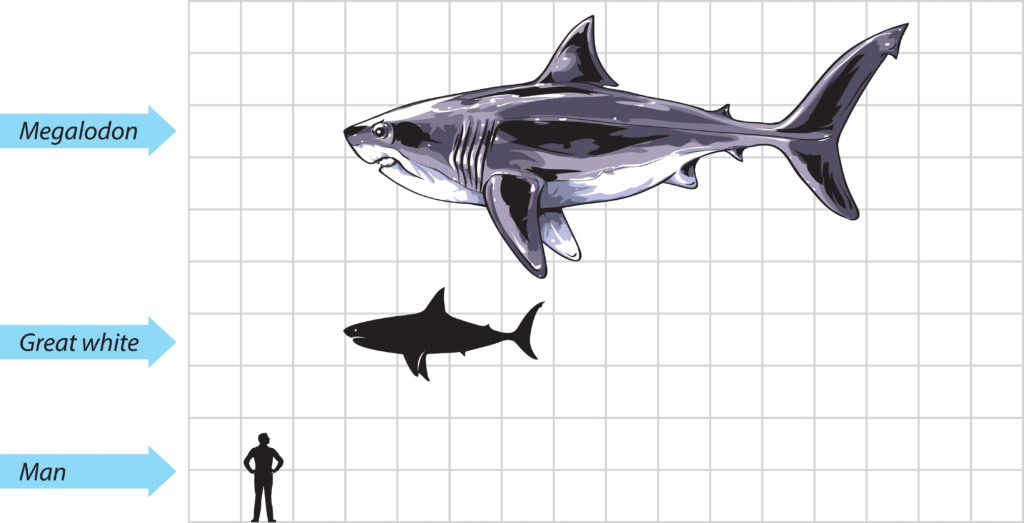
The largest known shark to ever exist is the megalodon (Otodus megalodon). The extinct species roamed the ocean about 20 million years ago.
For more than 100 years, paleontologists believed that the great white shark may have been a direct descendent of the megalodon. However, this theory was based on fossil evidence of teeth.
Due to limited fossil evidence, it was difficult for scientists to confirm the megalodon’s connection to modern shark species. However, a more complete shark fossil, scientifically described as Carcharodon hubbelli, has provided scientists with more insight into the evolution of great whites.
The fossil consisted of a full jaw with teeth and several vertebrae. The teeth were saw-like but not as sharp as great white shark teeth.
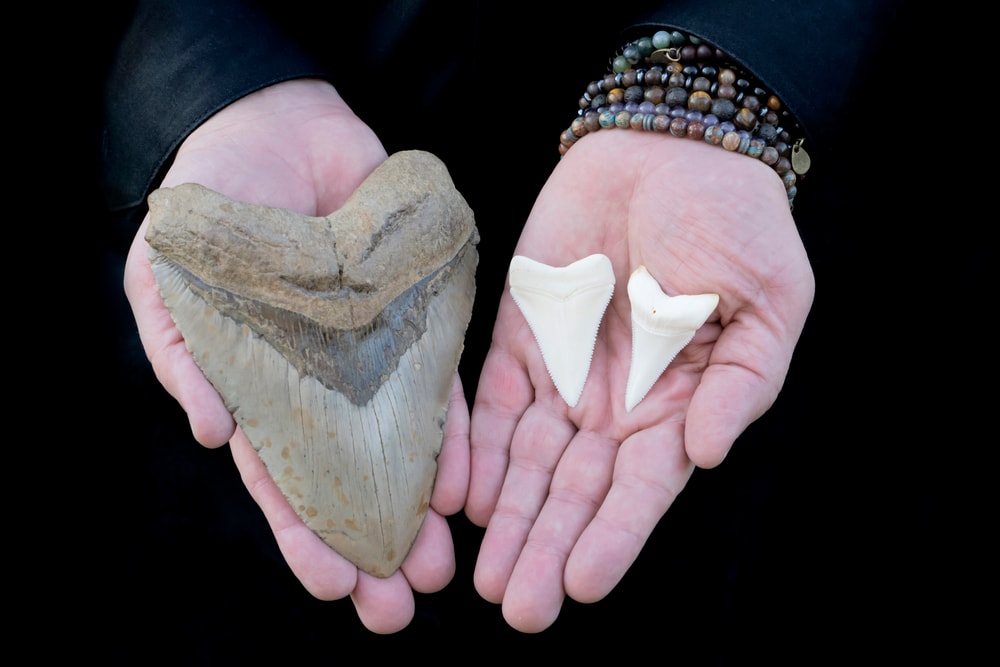
The teeth are described as being a link between the smooth teeth of the Mako shark ancestor, Carcharodon hastalis, and modern great white sharks.
The fossil was dated at around 6.5 million years old, which places it in a likely time frame to be an ancestor of the great white shark.
The theory that the Carcharodon hubbelli, also called the Hubbell’s white shark, is an ancestor of the great white rules out the theory that the megalodon is a direct ancestor of the great white.
Megalodons went extinct about 3.6 million years ago. Based on the size of their teeth, megalodons are estimated to have been around 49–59 ft (15–18 m) in length.
Aside from size, there are several differences between great white sharks and megalodon, such as:
- Megalodons had a bite force that was almost 6–10 times greater than that of a great white’s bite force.
- Megalodons had longer pectoral fins to support their body weight.
- Great whites have a more pointed, conical snout, while megalodons a rounder snout.
- It’s estimated that megalodons could weigh up to 100,000 pounds (45,359 kg), while large female great whites average about 2,400 pounds (1,089 kg).
Megalodons are believed to have gone extinct sometime near the end of the Pliocene Epoch.
The exact reason for their extinction isn’t fully understood. It’s believed that a phase of global cooling could’ve been a significant contributing factor.
A study conducted in 2022 suggests that great whites and megalodons have similar diets. Competition for food sources between the two species may have also contributed to the extinction of the megalodon.
You may also like: All 21 Different Types Of Whales: Guide, Pictures And Classification
Largest Shark in the World
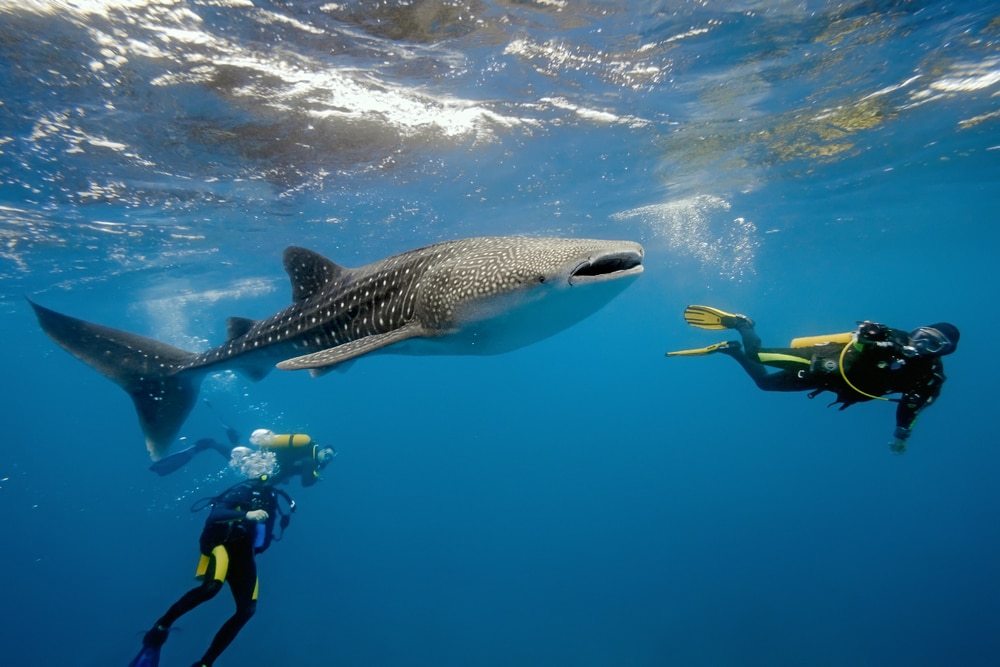
The whale shark (Rhincodon typus) is the largest fish and shark alive today. It can grow up to 39 feet (12 meters) in length.
The largest whale shark on record measured in at about 62 feet (18.8 meters) in length. Therefore, the largest whale shark recorded is about the same size as a large ancient megalodon.
Average-sized whale sharks weigh around 22,000 pounds (9,979 kg).
The whale shark is quite different from most shark species. Despite their massive size, whale sharks are labeled as gentle giants. They mainly feed on plankton and aren’t known to be aggressive. Their name comes from their size and whale-like feeding habits.
Whale sharks are filter feeders, like baleen whales. They swim through schools of plankton with their mouths wide open to feed and filter the water back out into the ocean.
Whale sharks are an open-ocean species. Some individuals may travel to coastal feeding sites, but this behavior is more common in juveniles. They have a widespread distribution but are most common in tropical waters.
You may also like: Are Sharks Mammals: Where Do Sharks Fit in the Classification of Animals?
Threats to Great White Sharks
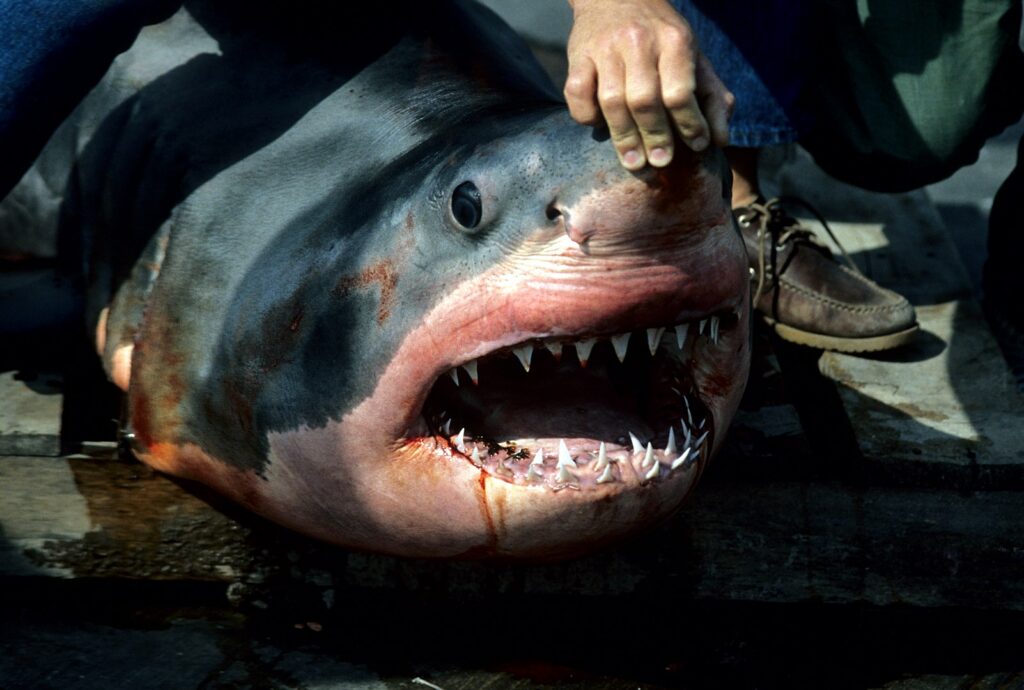
Since great white sharks are at the top of the food chain, they don’t have many predators. Great whites may fall prey to killer whales, but humans are their biggest threat.
There are several laws and regulations in place to protect the great white shark population.
The West Coast HMS Fishery Management Plan and the Consolidated Atlantic Highly Migratory Species Management Plan are responsible for managing the great white shark in US waters.
It’s also listed as an Appendix II species on the Convention on International Trade in Endangered Species (CITES) list. Appendix II species aren’t at risk of extinction. They receive protections so populations can be managed in an effort to prevent actions that would negatively impact a species’ decline.
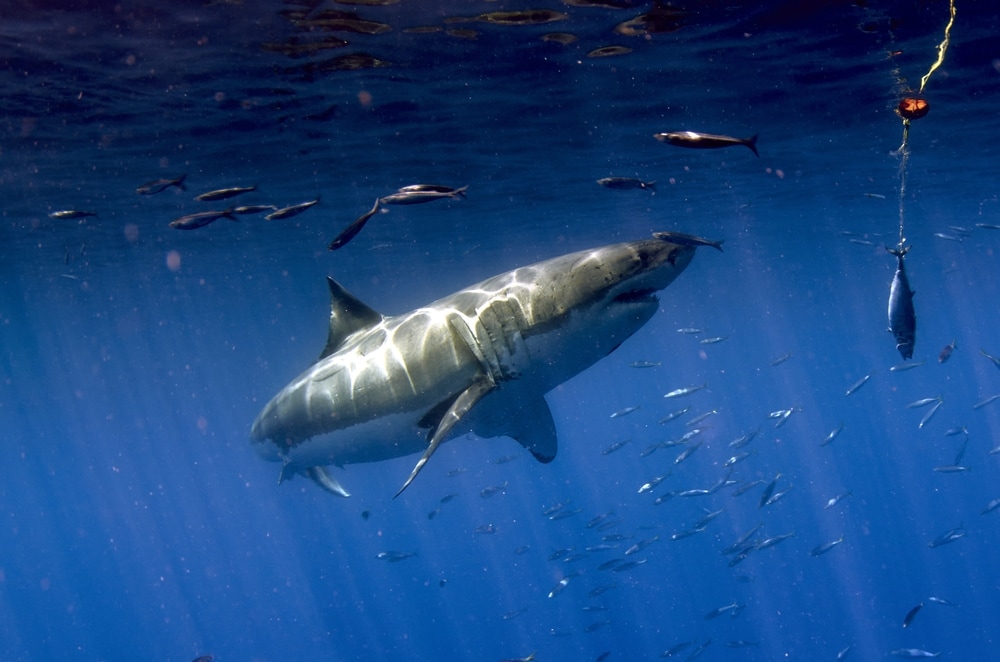
Some human-driven threats that great white sharks face include:
- Bycatch – Sharks are often victims of bycatch, which is the unintentional capture of marine animals while fishing for other fish or marine animals.
- Water pollution – Sharks can get entangled in marine debris, such as plastic waste, or become injured by ingesting plastics, microplastics, or other trash in the ocean.
- Illegal poaching – Although laws and regulations are in place, malpractice in fishing still occurs, and great white sharks are threatened by illegal poaching and harvesting.
According to the International Union for Conservation of Nature (IUCN), great white sharks are listed as a vulnerable species.
Great white sharks are considered vulnerable because the global population has experienced a 30–49% decline over the last 150 years.
The global great white population was last assessed in 2018. Some regional populations, including those in the northeast Pacific and Indian Ocean, are increasing. Populations in the northwest Atlantic and South Pacific are declining.
You may also like: Ancient Predators: How Long Do Sharks Live?
Fun Facts
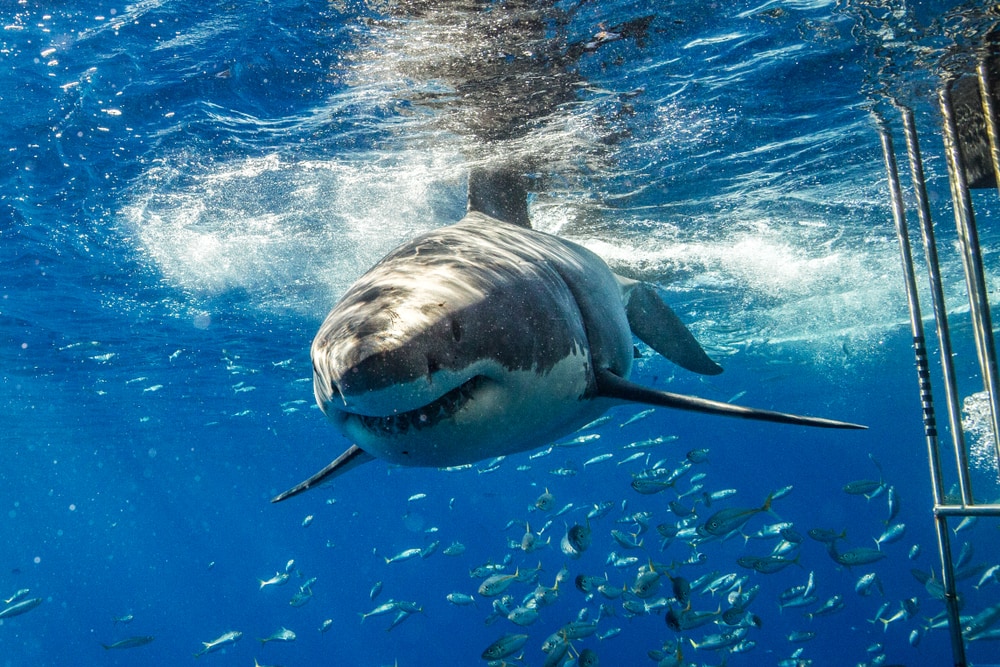

Sharks are vertebrates, but they don’t have bones.
Sharks have a cartilaginous skeleton, which means their skeletal system is made of cartilage. But sharks don’t have bones. Their skeletal system can be fossilized due to deposited calcium salts in the cartilage.

Great whites navigate the ocean using electroreception.
Great white sharks have electroreceptors called Ampullae of Lorenzini. This allows them to detect electrical currents.
Scientists have determined that great whites use this sixth sense to find their way throughout the open ocean. They do this by detecting electrical currents and orienting themselves in accordance with the Earth’s magnetic field.

The great white shark is one of the “Big Three” sharks.
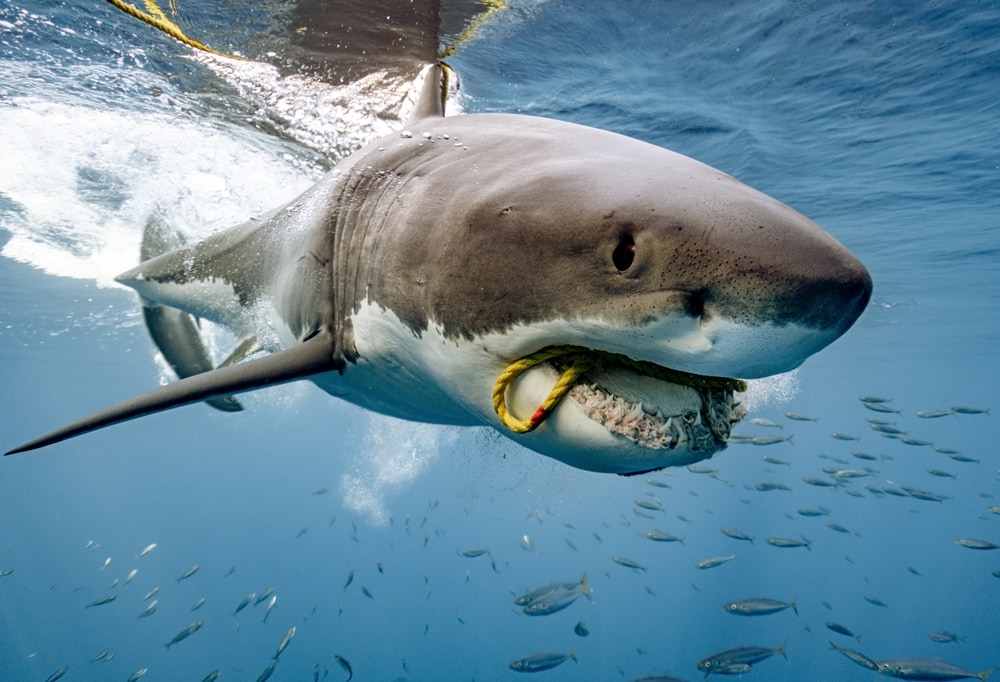
Great white sharks are number one in the “Big Three” group for sharks with the highest number of attacks. The other two sharks with the most attacks on record include the tiger shark and bull shark.
Based on data provided by the Florida Museum International Shark Attack File, the great white shark has been responsible for a total of 351 attacks as of June 2023. The tiger shark and bull shark have a combined total of 261 attacks.
Despite the high number of attacks, sharks are known to not like the taste of humans.
Great whites are known to be curious. They may bite humans due to their inquisitive nature or simply because they’ve mistaken a human for prey.
FAQs
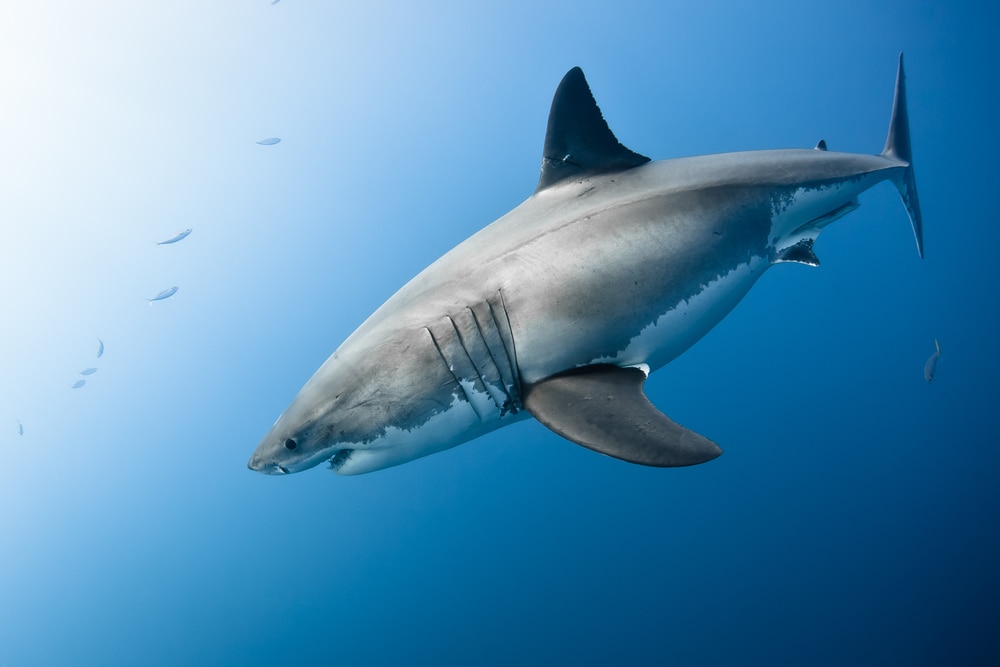
Is there a 40-foot shark?
The whale shark is the closest shark to 40 feet (12 meters). Some whale sharks may exceed this size and grow up to 60 feet (18 inches) or more. However, these sharks average about 39 ft (11.9 m) in length or less.
What is stronger than a great white shark?
The great white shark is the strongest shark species known. Killer whales, or orcas, are stronger than great whites because of their size. Most individuals range between 18 and 26 ft (5.5-8 m), but large individuals can measure up to 30 ft (9 m) or more.
Orcas are also known to be very intelligent creatures, capable of outsmarting great whites.
What eats a great white shark?
There are not many marine animals that prey on great whites because of their size. Killer whales are the only known predators of great whites besides humans. Orcas are capable of preying on great whites because of their size.
It’s believed that only certain populations of orcas feed on great white sharks.









